| Wolverhampton Corporation
Tramways - Electric Traction. |
|
Into Operation Once the decision had
been taken to use the Lorain System, and an Act of
Parliament had been passed to allow the work to progress,
the Tramways Committee quickly pressed ahead with the
conversion so that trams would be running in readiness for
the Wolverhampton Art and Industrial Exhibition in West
Park, which was due to open on 1st May, 1902. This was seen
as essential for the success of the exhibition because most
visitors would use public transport to get there.
Two initial routes were planned from Ettingshall Road to
Tettenhall, one along Tettenhall Road, and another via
Waterloo Road, and New Hampton Road. The first section from
Ettingshall Road to Cleveland Road, which would be used for
the initial trial, was completed on 13th January, 1902, and
inspected the next day by the Board of Trade.
Tests were carried out during the next two weeks,
including the running of a 15 ton steam roller, over the
track, up and down the route for a whole afternoon. Another
test used a traction engine to pull a 28 ton load over the
track. While this was happening, work progressed on a new
tram depot in Cleveland Road, capable of holding 60
tramcars. The building had a repair shop at the rear, which
had an overhead crane for moving heavy items. The depot
opened on 6th February, 1902. The first three tramcars used
on the Ettingshall Road track were supplied by the Lorain
Company. Two of them were single deck cars, one fully
enclosed, and one with open seating at each end. The other
was a double deck, open-topped car. Initial problems were
caused by pieces of scrap iron that had fallen onto the
track from open carts, used by the scrap merchants in
Bilston Road. The scrap iron was attracted to the magnetic
skates on the bottom of the tram, and caused short circuits.
Work on the track in New Hampton Road began in January
1902, after which the horse-drawn trams to Newbridge only
ran along Tettenhall Road as far as the junction with New
Hampton Road West. The various sections opened on the
following dates:
| Ettingshall Road to Cleveland
Road - 6th February. |
| Cleveland Road to Victoria
Square - 30th April. |
| Victoria Square to Coleman
Street - 1st May. |
| Victoria Square to Newbridge
via Tettenhall Road - 12th June. |
| Coleman Street to Newbridge -
11th August. |
| Newbridge to Wergs Road -
13th September. |
| Waterloo Road to Molineux
Road siding (for football matches only) - 20th
September. |
Another nine tramcars went into operation in May, in
readiness for the exhibition, and another six began to
operate in July and August. In March, the Corporation began
selling most of the horse-drawn tramcars and the horses. On
17th March, 1902 a horse-drawn tram service was started by
the Corporation on the Dudley Road route, running to
Fighting Cocks. The service, which was withdrawn on 22nd
December, 1903 was the Corporation's last venture into horse
drawn trams. |

|
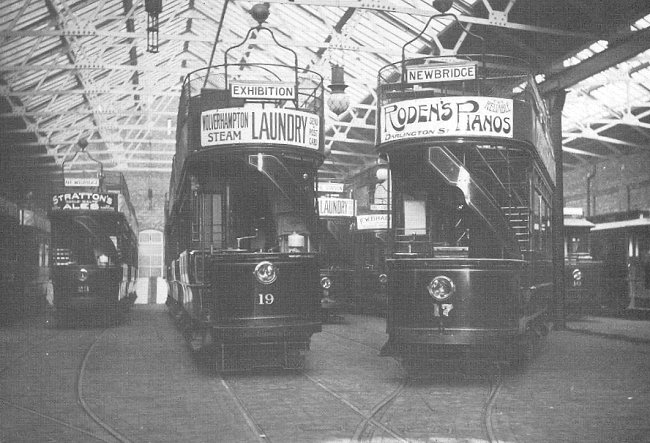
Cleveland Road Depot in October
1902. From 'Tramway & Railway World'. |
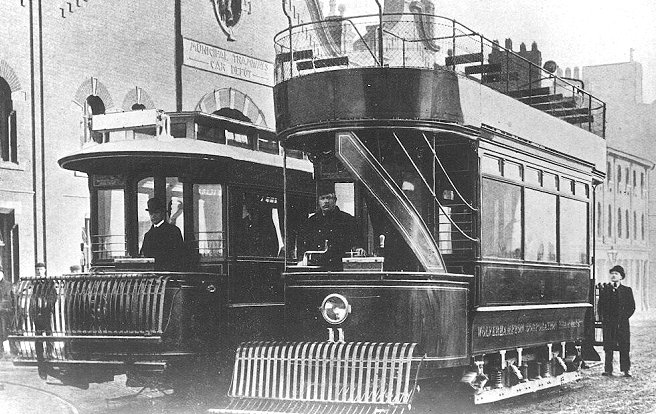
Two of the trams built by G. F.
Milnes & Company Limited, seen in May 1902, outside the
Cleveland Road Depot. From an old postcard. |
| As already mentioned in the article from 'The
Engineer', Mr. C. E. C. Shawfield, Borough Engineer,
submitted his critical report about the Lorain system to
the council in April 1903. The Borough Surveyor Mr.
George Green also submitted a report that listed the
shortcomings of the Lorain system. In his report he
stated that 24 percent of the granite casings on the
contact boxes were badly worn. The council met to
discuss the matter under the chairmanship of Alderman
Charles Tertius Mander who was in favour of the
continued use of the system. He felt that the use of the
system was essential to keep the
British Electric Traction Company at bay. He
stated that it was fighting tooth and nail to get
Wolverhampton tramways into its hands. The Mayor,
Alderman G. R. Thorne disagreed. He felt that the best
option would be to use overhead wires, which was the
cheapest system to run and maintain. At the end of the
meeting it was agreed that the use of the Lorain system
would continue, but the council would not purchase the
system outright from the company.
This led to a fierce dispute between the council and
the company. The council claimed that it was not fit for
purpose because it was not a commercial success, and was
unsafe for men and animals. Five months later an
agreement was finally reached, and approved at a council
meeting on 21st September, 1903. The Lorain Company were
to be paid £22,000 on account, and they were to supply
and fix 1,000 top plates with removable centres, plus an
additional 4,000 top plates, all without charge. When
this had been done, the council would pay the balance of
the contract price. |
|
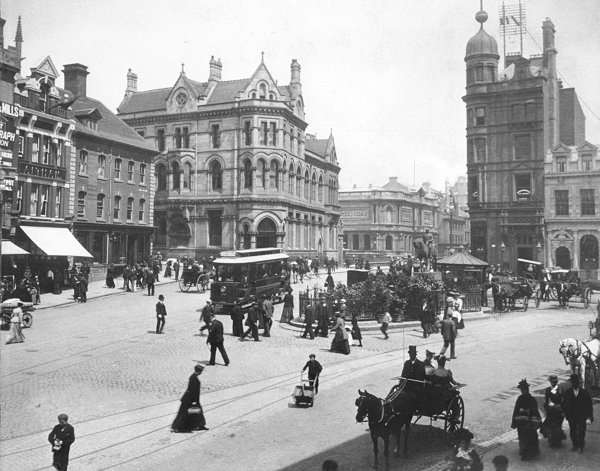
Car number 10 in Queen Square, on
its way to the 1902 exhibition. |
| New Routes The Lorain system
was extended with the opening of several new routes in
1904, all under the terms of the Wolverhampton
Corporation Acts of Parliament. The new routes and
opening dates were as follows:
| 8th March |
Snow Hill to Fighting
Cocks |
| 2nd April |
Horseley Fields to
Coventry Street |
| 23rd April |
Coventry Street to Deans
Road |
| 22nd June |
Princes Square to Church
Street, Heath Town |
| 13th August |
Waterloo Road to Bushbury
Lane |
| 31st October |
Church Street, Heath Town
to New Street, Wednesfield |
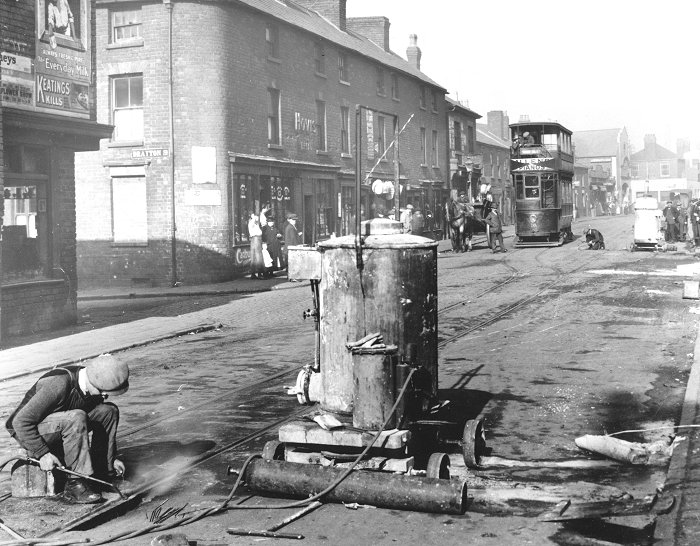
Repairs to the track in Dudley
Road as a Lorain tram from Snow Hill approaches.
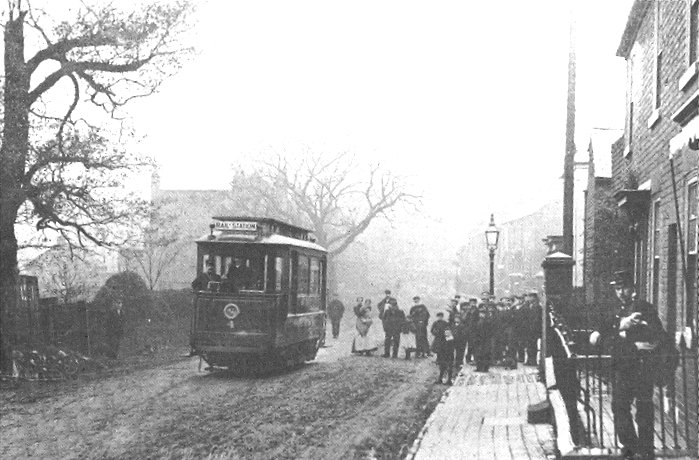
A tram at the initial terminus
of the Wednesfield route, in Wolverhampton Road.
In 1904 the Corporation received a
further six double deck, open-topped tramcars, and
another four closed, single deck cars. The whole
network came to a halt in Christmas 1906 after a
heavy fall of snow, followed by rain, and a heavy
frost. This left a layer of ice over the rails and
contact boxes, which had to be chipped away by hand.
It took three and a half days to clear it all away.
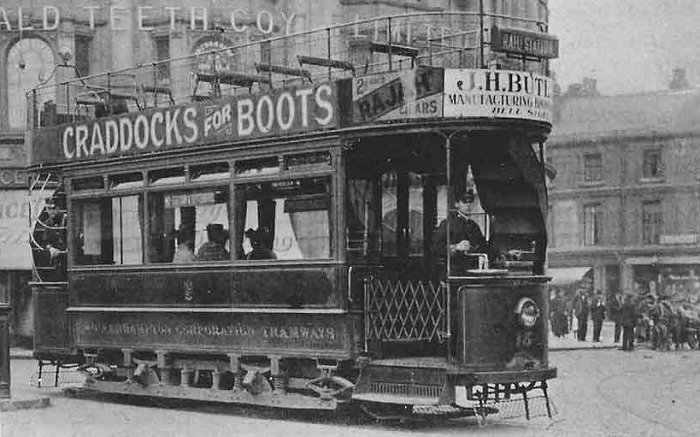
A Wolverhampton
Corporation Lorain tram passes through
Princes Square on its way to Victoria
Square, where it terminated for
passengers for the high level or the low
level railway stations. |
In 1909, after the reconstruction of
Queen Square, and the widening of Worcester Street,
work began on the line to Penn Fields. The new route
opened on 10th September, 1909. It ran from Victoria
Square to Stubbs Lane, via Lea Road. This completed
the Lorain network, which covered 21½
miles of single track. Six more double deck,
open-topped tramcars were purchased for use on the
new route.
|
|
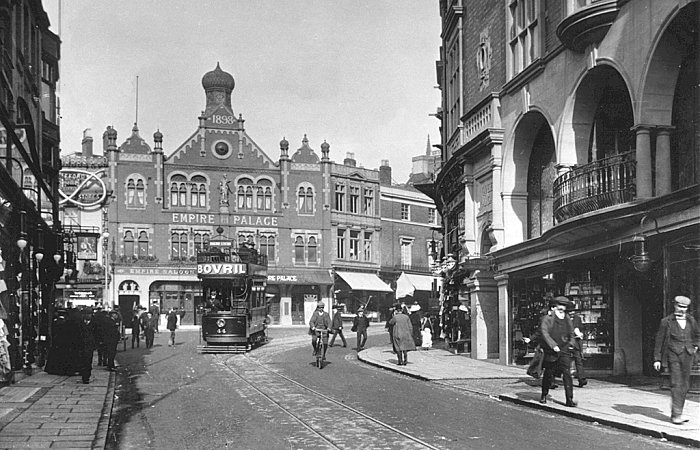
Car number 44 built by the United
Electric Car Company Limited, approaches Queen Square. |

Wolverhampton Municipal Tramways staff in
1910.
| The
British Electric
Traction Company and the Corporation
For several years,
Wolverhampton Corporation had successfully prevented the
B.E.T. Company from extending its routes into the centre
of Wolverhampton. This annoyed many members of the
travelling public, and local businessmen who had to
frequently change trams as they travelled to and from
Wolverhampton.
The Corporation came
under a lot of pressure to allow through-working from
Wolverhampton to the surrounding towns, but would still
not allow unsightly overhead wires in Wolverhampton town
centre. In February 1905 a provisional agreement was
made between the Corporation and B.E.T., allowing each
to run dual-system tramcars, capable of running on
each-others network.
Some corporation
tramcars were soon fitted with overhead trolley
equipment, and a through service began between
Wolverhampton and Bilston Town Hall on the 9th November,
1905, followed by a through service from Wolverhampton
to Willenhall Market Place which began to operate on
18th April, 1906.
Things were not so easy
for B.E.T. whose tramcars were six inches narrower than
those operated by the Corporation, and so difficult and
expensive to modify. Wolverhampton District cars began
to run a through service from Dudley to Wolverhampton on
15th October, 1906, but it was to be short-lived. The
Lorain equipment that had been fitted to the trams
weighed nearly one ton, which greatly increased the
consumption of electricity over the hilly route. The
trams became uneconomical to run, and as the Corporation
would not allow overhead wires on its section of the
route, the through service ended in January 1909.
Until 1911 all of
Wolverhampton Corporation's double deck trams were open
topped, because the Board of Trade felt that closed-top
models were unsafe in high winds. The Board of Trade
recommended that if closed-top double deck tramcars were
used, a number of open-topped cars should be kept in
reserve for use when necessary. In wet weather
passengers naturally headed for the lower covered
saloon, which often became overcrowded. In 1911 the
Tramways Committee decided to add top covers to six
cars. They were a great success, and so another seven
were later modified. |
|
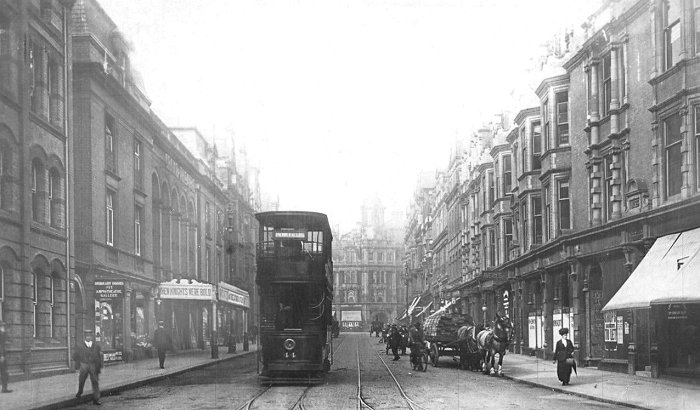
A tram built by the United
Electric Car Company Limited, with an added top cover. Seen in Lichfield Street
sometime after 1911.
From an old postcard. |
| Around the same time, drivers were complaining that the
open-fronted trams were a danger to their health. As a
result, from 1911 cars were fitted with vestibules.
Overhead Wires
In October 1919, the General Manager of Wolverhampton
Corporation Tramways, Mr. Charles Owen Silvers submitted a
report to the Tramways Committee, drawing attention to the
bad state of the track, much of which needed to be renewed.
He also advocated the conversion of the network to an
overhead wire system. Much of the single track also needed
to be replaced with double track to accommodate the
increasing amount of traffic. The cost of this conversion
using Lorain contact boxes would be prohibitive. In June
1920 the report was discussed at a council meeting, and the
findings were approved. The expected cost of conversion to
overhead wires was expected to cost around £375,000.
In 1920 the Corporation received its last tramcars fitted
with Lorain equipment. They consisted of three double deck
cars, and three single deck cars, all built by Dick, Kerr &
Company Limited. The single deck models were also fitted
with poles and trolleys for use with overhead wires.
Work on the conversion to overhead wires began in January
1921, and had been completed by mid October. The various
routes were equipped with poles and overhead wires, and
opened on the following dates:
|
Date |
Route |
Service Number |
| 26th March |
Dudley Road |
8 |
| 15th June |
Bilston Road |
7 |
| 22nd July |
Willenhall Road |
6 |
| 28th July |
Wednesfield |
5 |
| 28th August |
Whitmore Reans |
2 |
| 1st October |
Bushbury |
3 |
| 5th October |
Tettenhall |
1 |
| 15th October |
Penn Fields |
4 |
The conversion, carried out under the
direction of Mr. Silvers, involved the fitting of around
1,100 poles, all of which were stronger than necessary
so that they could also be used for a possible
conversion to trolley buses. As each route opened, the
Lorain gear was removed from the trams, each of which
then weighed about one ton less. Although no longer
used, the Lorain contact boxes remained in place until
either trackwork, or roadwork was undertaken.
Early in 1922 the Corporation purchased
its last new tramcars. The eight tramcars were built by
the Brush Electrical Engineering Company Limited, and
were long wheelbase single deck cars.
On 16th January 1923, members of the
Tramways Committee inspected the trolley buses in
operation at Birmingham. Mr. Silvers submitted a report
to the council recommending the conversion of the
existing Wednesfield line to trolley bus operation. This
was approved by the council, and the trolley bus service
to Wednesfield began on 29th October, 1923. Within the
next five years all of Wolverhampton Corporation's trams
had been replaced. The last tram journey on the
Corporation's system took place on 26th August, 1928.
The tram ran from Bilston to Cleveland Road Depot.
|
|
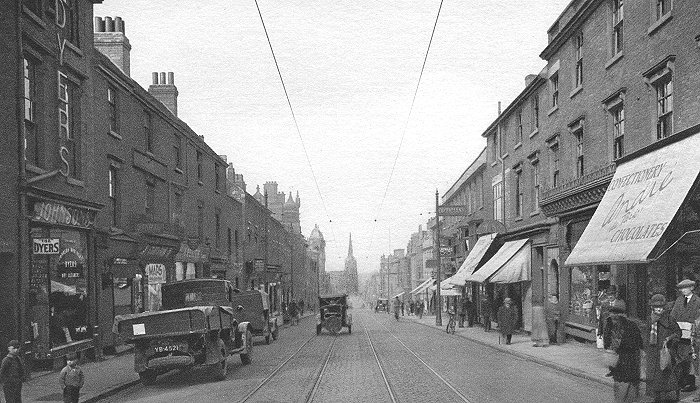
The tram wires in Darlington
Street. |
 |
|
 |
|
 |
|
Return to
Beginnings |
|
Return to the
electric trams menu |
|
Proceed to
Trolley Buses |
|